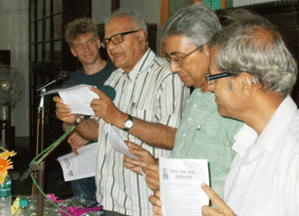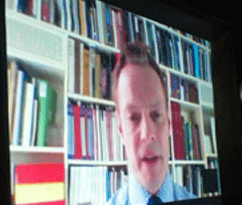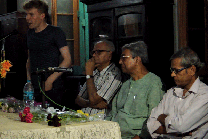|
|
|
|
|
|
| Sadharan Brahmo Samaj Library Newsletter inaugurated |
 The bi- monthly newsletter of the Sadharan Brahmo Samaj library was inaugurated at a wonderful function on 24th May 2014. The newsletter was inaugurated by Prof Arun Ghoish who is a well kjnown librarian and has more than 50 years of association with this library. The bi- monthly newsletter of the Sadharan Brahmo Samaj library was inaugurated at a wonderful function on 24th May 2014. The newsletter was inaugurated by Prof Arun Ghoish who is a well kjnown librarian and has more than 50 years of association with this library.
Speaking at the occasion Prof Ghosh stressed on the need of the newsletter to be brought out as this is an important part of the history and will have far reaching foot prints in the history of time. He recalled in the 1960's when Prof Dliip K Biswas invited him along with his friends to work and catalogue books in this library. These old libraries are not simple libraries per se but an epitome of the history and the time that they represent. He also stressed that is is imperative that these libraries such as these should function as they house a treasure trove of history and a vast amount of intellect. This is a part of ourt giveback to the society. The information that this newsletter carries will have far reaching effects for future researchers
 As this was the period when we celebrate the birth anniversary of Rammohun Roy - it was more befitting that a talk was delivered by David Wilson, the noted art historian from London. David joined over Skype and gave us a full account of the plaster bust of Rammohun that is on display at the Samaj - along with the bust of Rammohun that was made by George Clarke. As this was the period when we celebrate the birth anniversary of Rammohun Roy - it was more befitting that a talk was delivered by David Wilson, the noted art historian from London. David joined over Skype and gave us a full account of the plaster bust of Rammohun that is on display at the Samaj - along with the bust of Rammohun that was made by George Clarke.
David also touched upon the famous portraits of Rammohun by Henry Peronnet Briggs around 1831-2, a commission from Miss Castle and American painter Rembrandt Peale's Portrait of Rammohun Roy, apparently painted at London in August, 1833, about six weeks before Rammohun's death and shortly before he made his final journey, to Bristol. He mentioned that what seems to have been largely unknown until last year (2013) is that Rammohun Roy was sculpted in marble by one of the leading sculptors working in London in the early 1830s. Read the full transcript of David's speech here
Prof. Goutam Neogi, retired Professor of History, Uttarpara College informed the audience of the history of the library. The Sadharan Brahmo Samaj was set up on 15th May 1878. There was no formal house for the Samaj and the foundation stone for the present Samaj building was laid in 1879 by Sib Chunder Deb. The library started in 1879 - but it was not accessible to the general public. It was Durga Mohan Das's words to Sivnath Shastri that prompted the set up and it had only religious books. Initially the library was set in 45 Beniatolla Lane and it operated out of that premises for the next 2 years. After that period the library moved to the Samaj mandir itself, where it housed the books of the Calcutta Congregation in the second floor of the Samaj mandir. It continued in this fashion till 1893 after which it moved to the separate building where it functions even now.
During this period the Brahmo movement was in its
hey days and many scholars came to the Brahmo Samaj
from different parts of the world. During this period
Karl Hammergreen - a Swede by birth visited the
Samaj. He had converted to theism in his own country
and came here to see the Brahmo Samaj and lived
amongst the fellow Brahmos. He also expressed a
desire to have a full fledged library for intellectual
nourishment. But Karl met an untimely death here
in 1894. Also we find Mohini Mohon Bose donate his
entire collection to the library. From 1894 to 1924
the library developed into a flourishing one and
many people availed the service of the reading room.
Ananda Mohan Bose, Debendranath Tagore, Gurucharan Mahalanobish,
Sib Chunder Deb, Umesh Chandra Dutta etc, donated
books and money for the library. During this epriod
we see intellectual discourses being held at the
 library - the discussion ceased to be ecclesiastic
but focussed more or social, political and international
affairs. library - the discussion ceased to be ecclesiastic
but focussed more or social, political and international
affairs.
The next two era are the periods of 1924 - 1947 and post independence. Many people have donated their personal collectiona dn many authors have donated their books at the library. It would be interesting to note that Rammohun;'s biographer Miss Sophia Dobson Collet - donated her entire personal collection to this library.
Dr. John Stevens of the School of Oriental and African Studies (SOAS) in London, also addressed the gathering. |
|
|
|
|
|